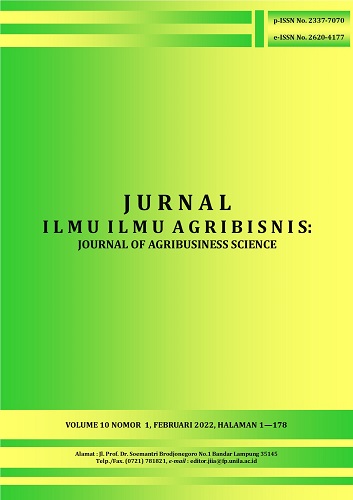POLA KONSUMSI PANGAN DAN STATUS GIZI ANAK BALITA DI DAERAH PANTAI KECAMATAN TELUK BETUNG TIMUR
DOI:
https://doi.org/10.23960/jiia.v10i1.5693 Abstract View: 710
Abstract View: 710
Abstract
This study aims to determine the pattern of food consumption and nutritional status of under five year children (toddlers) at the coastal areas of Teluk Betung Timur Distric with secondary data description method. This research is part of an umbrella study conducted in three areas in Bandar Lampung City, namely the highlands, lowlands, and coastal areas. The research sample in this study was 32 children aged 12-59 months. The data was analyzed by scoring the Desireble Dietary Pattern (DDP) to determine the food consumption pattern of toddlers and nutritional status assessment. The results showed the level of Energy Adequacy (TKE) of toddlers at the coastal areas of Teluk Betung Timur District of 110.13 percent which can be categorized as normal. Toddlers with an energy deficit of 5 toddlers (15.63%) while toddlers who experienced excess energy as much as 12 toddlers (37.15%). Only one toddler has a deficit of vitamin A while there are 19 toddlers who have a calcium deficit. The results showed the DDP of toddlers was only 72.32 which can be interpreted that DDP of toddlers have not reached the maximum score. Toddlers at the coastal areas of Teluk Betung Timur District who experienced malnutrition as much as 21.88 percent; stunting toddlers as much as 28.13 percent; and skinny toddlers as much as 15.63 percent.
Key words: DDP, food consumption patterns, nutritional status, toddler
Downloads
Downloads
Published
How to Cite
Issue
Section
License
Authors who publish with this journal agree to the following terms:
Authors retain copyright and grant the journal right of first publication with the work simultaneously licensed under a Creative Commons Attribution License that allows others to share the work with an acknowledgement of the work's authorship and initial publication in this journal.
Authors are able to enter into separate, additional contractual arrangements for the non-exclusive distribution of the journal's published version of the work (e.g., post it to an institutional repository or publish it in a book), with an acknowledgement of its initial publication in this journal.
Authors are permitted and encouraged to post their work online (e.g., in institutional repositories or on their website) prior to and during the submission process, as it can lead to productive exchanges, as well as earlier and greater citation of published work (See The Effect of Open Access).














